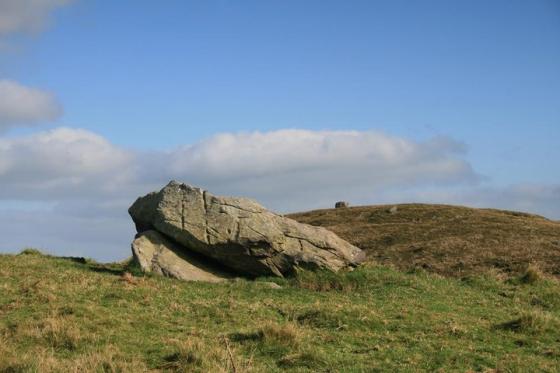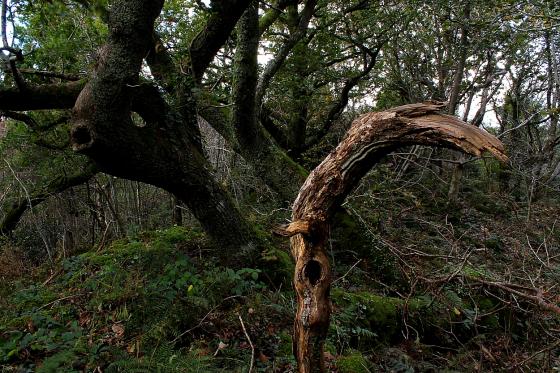There are, I reckon it’s fair to say, both positive and negative attributes to ‘spontaneous action’. Ah, spontaneity: anathema to some – the methodical thinkers, planners, those with compartmentalised car boots ensuring everything is always in its right place (one assumes Thom Yorke is an advocate?)... yet a prerequisite to others – the instinctive, inquisitive, opportunistic, the reckless, even? As for myself, I guess I fall between camps... as I do for most things nowadays. Implacable opposition to religious and political extremists (particularly farcically ignorant, far left champagne socialist ‘rappers’) naturally proving the rule. Yeah, plan for the worst, but be prepared to improvise at short notice. Seize the opportunity. Speaking of which...
A passing shower, pounding upon what back in the day would’ve been canvas, wakes me with a jolt at Fferm y’ Rynys, my tent, if not exactly in the shadow of the great long barrow of Capel Garmon – unfortunately sunshine is required for such a phenomenon – certainly not too distant. Upon gingerly emerging from my erstwhile cocoon I note a seemingly immutable mass of opaque, grey vapour looming where the elegant profile of Moel Siabod should be to the west. Should be, but as experience informs, all too often isn’t. Nevertheless, as dawn gives way to early morning, these clouds progressively realize a warmer, more optimistic glow suggestive of change... sufficient, in fact, to prompt me to head toward Capel Curig to see what’s what. One of the wettest places in the UK? What could possibly go wrong? However, sure enough, Moel Siabod’s facade is present and very much correct, towering above the cascading Afon Llugwy at Pont Cynfyg. Now there are some that maintain rivers ‘talk’ – divulge their story, if you will – to the susceptible. If so, perhaps the Afon Llugwy should be accorded a PG rating? Whatever, the subconscious duly primed, the penny finally drops upon passing the shiny 4x4s aligned outside Plas-y-Brenin... why not reacquaint myself with the summit cairn? Ah, the moth to the flame....
Spontaneity triumphs in the ensuing deliberations and – before I have the opportunity to reflect and countermand – I set off, skirting the eastern extremity of the Llynnau Mymbyr to ascend into the trees, that familiar, intoxicating blend of nervous excitement/determination/what-the-hell-am-I-doing-you-muppet? to the fore. The path is initially heavy going underfoot: wet rock, slippery following the recent rain, the slitheryness factor exacerbated by fallen leaves... however, as height is gained and the woodland left behind it morphs into a straightforward grassy/muddy plod all the way to the top. Well, almost, that is. More-or-less. That ‘the top’ is a very long time coming – and takes everything I’ve got in my available energy reserves – probably signifies more about it being some thirteen years since my last ascent of this mountain than anything else. But there you are. With grandstand retrospective views to Y Glyderau and Y Carneddau, thankfully unimpeded by the cloud of morning, to animate the all too necessary frequent pauses... a traveller can’t exactly complain, can he? Not that any spirits or other similar manifestations contravening the laws of physics that may – or may not – frequent this apparent behemoth beached humpback whale of a mountain, would give a monkey’s if I did. Eventually, I reach the crest of the summit plateau, whereby the landscape suddenly explodes – hell, like John Hurt’s chest in Alien – into a shattered disarray of mechanically weathered dolerite intrusion. Yeah, the ‘shapely hill’ bears its jagged teeth in no uncertain manner assuring further onward progress is no easy matter.
Finally, there it is. The cairn. Now as upland cairns go... structurally speaking, it is a poor example, having been hollowed-out by successive multitudes of unschooled walkers to provide shelter from the wind. Or rather, to judge by the very significant footprint, a pale evocation of its former self. Unfortunately, all this is to be expected in this day and age. Anyhow, noting that, owing to my early start, none of the aforementioned muppets is as yet on the scene, I take the opportunity for closer inspection. But not before applying every item of kit I have brought with me in an – although not totally successful – at least B+ attempt to keep out the punishingly brutal cold wind. No need to vandalise scheduled prehistoric monuments... if you understand your environment. Funnily enough, it does tend to be windy upon mountain summits. Although it has to be said that the application of thermal underwear over boots is not to be recommended. Not a good look. Although observing what passes for ‘fashion’ these days I’m pretty sure someone would buy it.
Anyway, the solo exploration reveals unexpected detail: a large slab and associated lesser fragments suggestive of a former cist, an assumption given further credence by what look very much like two small orthostats still remaining in situ within the ‘shelter’. How these have survived the millennia upon such a popular mountain is beyond me, it really is. And yes, the circular footprint is indeed much more extensive than I recall. But it is where they put it that counts. Yeah, the archaeology, of course, is but of secondary importance to the sense of place. It is the landscape context that makes this the archetypal spot to set your Bronze Age VIP on the road to eternity. Or David Byrne’s ‘nowhere’, depending upon your point of view.
Although this is my fifth visit over the years, the spellbinding vistas nevertheless continue to blow the mind. The key here is Moel Siabod’s isolated location, standing aloof at the eastern extremity of Y Moelwynion and, to be honest, sharing little of the characteristics of its neighbours. Its elevation, measuring up at a very respectable 2,861ft, is also noteworthy thus ensuring the aesthetic dividends to be enjoyed here are among the finest in all Snowdonia. In my opinion. Today, all the old friends are present and correct: to the north, beyond the eastern heights of Y Glyderau and the obscurely wondrous long cairn at Bwlch Goleuni, are the massed summits of Y Carneddau bristling with upland cairns; to the northwest across Dyffryn Mymbyr and its cists, the chaotic, natural rockpiles of Glyder Fach and Glyder Fawr separated by the unearthly Castell-y-Gwynt... the latter in its element today overlooking the soggy stone circle beside lonely Llyn Cwmffynnon; directing the gaze further west, beyond Llanberis Pass, is the Snowdon Massif, sentinel peak Yr Wyddfa subsumed within its customary cloak of grey; then Nant Gwynant and Y Cnicht... the remainder of Y Moelwynion, some peaks standing in mute, ravaged homage to Wales’ former industrial heritage; eastward toward Betws-y-Coed (reversing my dawn view), the moors of Denbighshire, Y Berwyn. In fact, it is only to the south that the iconic 360-degree panorama is interrupted... by the summit itself. Easily rectified. Ah, there you go. The Migneint and Southern Snowdonia. Tick.
Here the uninitiated punter will be in for a shock, the bulbous form of Moel Siabod’s northern flank – so apparently benign when viewed from the shores of Llynnau Mymbyr – catastrophically transformed in an impressive display of naked rock plunging toward the gaunt, restored keep of Dolwyddelan Castle, set far below within Cwm Lledr. Here, too, is Daear Ddu, a superb natural route of ascent (one of the finest in Snowdonia) from the glacial corrie tarn Llyn-y-Foel, a shining glint of water visible sheltering far beneath the towering north-eastern ridge. It was here (at SH71005520) that, if Coflein is to be believed, a fabulous Bronze Age shield was discovered in 1784. Surely not? But then again, what an appropriate location! I make an extended stop here to delay returning to the increasingly more popular summit, my mind swimming as a rainbow arcs across the void. Was there really a priceless treasure to be found at its base a couple of centuries past? Whatever the truth, there is certainly priceless treasure of a more metaphysical nature to be experienced here today. Steady now. But don’t just take my word for it... similarly impressed, by all accounts, are a couple of ‘scally’ climbers struggling past... we share a brief mutual epiphany. Top lads, eyes aglow with wonder.
With a little over an hour or so before I must begin my descent, I return to the now deserted summit... and find Moel Siabod has one more surprise for me today. With minimal warning – as if a boxer flooring his opponent with a zero backlift uppercut – the cloud base swirling above Cwm Lledr and the excellent Y Ro Wen suddenly envelopes all, sending me into a claustrophobic environment of looming apparitions and spiralling wraiths of moisture. An abstruse world seemingly for my eyes only. The sun, however, refuses to submit... and, upon executing a 180, I find myself face to face with... myself. A Brocken Spectre, a rainbow kaleidoscope of colour illuminating my shadow as if I’ve become the ‘Ready-brek Kid’ styled by JMW Turner himself. That’s making the assumption it wasn’t the former occupant of the nearby cairn going walkabout? Or a ghostly warrior muttering ‘I’m sure I left it hereabouts?’ No, definitely the wind. I think. Wow, what a finale.
Returning to the cairn I make a compass bearing for Plas y Brenin and, after confirming this with one taken earlier (as is my way) and throwing a respectful nod to times – and people – past, I set off back down the mountain. Overjoyed, but a little unnerved, too. Emerging from the gloom I find my bearing is true, but nevertheless I’m quite a way to the west of the path. Rain moves in during the final half-mile and I realise my window of opportunity was indeed but fleeting. Spontaneity, eh? I’m all for it. But best take a compass....
























































































































































































